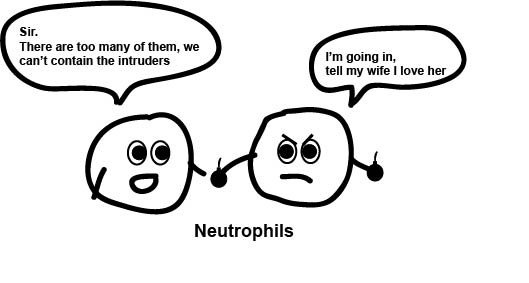
In my previous article, How the Immune System Can Promote Metastasis we focused on a particular immune cell type involved in cancer metastasis, called the tumor-associated macrophage (TAM) and how this cell type is recruited to, and manipulated by tumors to promote primary tumor growth and metastatic spread. In this article I would like to review another important immune cell type implicated in promoting the spread of tumors to secondary sites, the neutrophil. In order to understand how neutrophils are involved in metastasis it is important to understand first how they are involved in normal immune responses. The immune system, as previously discussed, is highly complex and is made up of many different cell types that belong to one of two arms, the innate immune system and the adaptive immune system. Neutrophils, like macrophages, are part of the innate immune system and they are an essential component of the ‘first line of defense’ immune responses. In fact, neutrophils are the most abundant immune cell type found in the circulation and are typically the first cell type to arrive at sites of infection or damage. Neutrophils are laden with what we call ‘cytotoxic granules’ which essentially contain a vast number of different toxic or anti-microbial products. Neutrophils release these granules in order to kill invading pathogens; the end effect is essentially like releasing a cluster bomb, maximum impact and maximum damage. If the initial onslaught of granules is not sufficient to destroy the pathogens, neutrophils will self-destruct, leading to the release of their entire load of toxic molecules and hence total destruction of the surrounding environment. It is because of this that neutrophils are often referred to as the kamikaze pilots of the immune system. Neutrophils, and their granules, are essentially the primary reason for the formation of pus, which, for the most part, is composed of digested fragments of cells and tissues resulting from the toxic effects of neutrophil granules. So next time you sustain a pussy wound, take a moment to appreciate all of the neutrophils that gave their lives to keep you healthy.

It was originally thought that the presence of neutrophils in tumors was indicative of a failed attempt to destroy the tumor and hence it was believed that neutrophils did not play any role in promoting tumor growth and progression. As a result, the roles of neutrophils in cancer remained mostly unstudied. However, it is becoming clear that neutrophils can in fact promote tumor growth and progression to metastasis. Like macrophages, neutrophils are also highly complex and functionally plastic. However, unlike macrophages, the full functional spectrum of neutrophils is not yet fully understood. Despite this, new data indicate that the normal functions of neutrophils can be hijacked by tumors to promote their own growth and spread.
As I discussed previously, tumors themselves are also highly complex, and are comprised of many different cell types (both normal and cancerous), a vast number of different molecules, as well as complex signaling networks; the collective term for this is the tumor microenvironment. In order for tumors to survive and progress they need to:
Tumors are not actually capable of carrying out most of these functions alone; hence they trick the normal cells (such as immune cells) in the tumor microenvironment into helping them. We know that immune cells are commonly found within the tumor microenvironment and that TAMs carry out a number of functions that promote the processes required for tumor survival, growth and metastasis. However, it appears that TAMs are not the only cell type recruited by tumors for this purpose. Neutrophils are also actively recruited to tumors, and the tumor manipulates the recruited neutrophils to turn into tumor-associated neutrophils (TANs) which carry out pro-tumor functions. New studies show that TANs also play instrumental roles in promoting tumor growth, survival and metastasis. More importantly, some studies have also shown that in the absence of TAMs, TANs can take over the pro-tumor roles typically carried out by TAMs. I’ll discuss this in more detail later but first let us take a look at the pro-tumor functions of TANs.
Like macrophages, neutrophils are capable of regulating immune responses as part of their normal functional spectrum and, just like with TAMs, tumors hijack the normal immunosuppressive functions of TANs to control anti-tumor immune attacks. You may recall from my previous article that adaptive immunity is the highly specialized second line of defense, and that tumors need to suppress adaptive immune responses in order to survive. Neutrophils secrete factors that can do this, for example arginase 1 (Arg1) suppresses the activity of a key adaptive immune cell type; cytotoxic T cells. These T cells generally pose the biggest threat to tumor survival.
In addition to their immunosuppressive functions, TANs can also release a number of factors that promote tumor survival and growth, some of which they secrete themselves and some that they liberate from the extracellular matrix (ECM). The ECM is a major component of the tumor microenvironment. Under normal conditions, the ECM is essentially a support structure; it holds things in place and provides scaffolding. The ECM surrounds all solid tumors. Within the ECM are found a vast array of molecules which can stimulate a number of different functions or provide a number of different signals both to tumor cells and the normal cells found in tumors. However, they need to be freed from the ECM before they can be of any use to the tumor. TAN-derived factors degrade the ECM and release these molecules; for example, growth factors that, unsurprisingly, can stimulate the survival and growth of tumor cells, and pro-angiogenic factors which induce the growth of new blood vessels. The generation of new blood vessels is essential for tumor survival. Without new blood vessels the tumors do not receive sufficient supplies of oxygen and nutrients and they either die, or do not grow beyond 2-3 mm2 in size. In addition to liberating pro-angiogenic factors from the ECM, TANs alone are also capable of stimulating new blood vessel growth.
In addition to housing various molecules, the ECM also provides a barrier between tumor cells and the circulation, one that tumor cells must cross in order to metastasize. During normal immune reactions neutrophils must migrate from the circulation into the inflamed tissue. They do so by migrating through the ECM. It has been proposed that TANs may leave a ‘channel’ in the ECM during migration into tumors and that invading tumor cells take advantage of this ‘channel’ to leave the primary tumor more easily. It has also been proposed that tumor cells may also ‘piggy-back’ onto TANs in order to escape into the circulation from the primary site. However, there is insufficient evidence at this stage to know if either of these hypotheses are true and further studies are required to verify these theories. Although it is not yet completely clear how neutrophils are involved in metastasis accumulating evidence shows that they most certainly are involved. Increased numbers of circulating neutrophils have been associated with increased metastasis in preclinical models and emerging data suggest that neutrophils can also promote tumor growth at metastatic sites via the mechanisms described above.
The evidence I’ve discussed above, and in my previous article, demonstrates that both macrophages (TAMs) and neutrophils (TANs) play important roles in promoting tumor growth and progression to metastasis. However, the functions of macrophages and neutrophils are very closely linked, and in fact these two cell types regulate each other. For example, in order to resolve inflammation macrophages must ingest dead neutrophils. This then changes the phenotype of macrophages. Conversely, macrophage-derived factors can influence the phenotype of neutrophils. Furthermore, macrophages and neutrophils can carry out many of the same functions during immune responses. This provides an extra back-up, a contingency plan in case something goes wrong. It is becoming increasingly apparent that the same relationship exists in tumor-associated macrophages and neutrophils. For example, in preclinical models, depletion of TAMs can result in a compensatory recruitment of TANs. These TANs then take over the tumor-promoting functions that are normally seen in TAMs such as immunosuppression and stimulation of angiogenesis. Other studies have shown that inhibiting TAMs and their precursors, monocytes, can increase metastasis and that this increase was associated with an increase in TANs, and circulating neutrophil numbers. Further to this, in some preclinical models, depletion of TANs and neutrophils more effectively reduces metastasis than depletion of TAMs and macrophages. However, in other models the opposite has been observed. Collectively, these data suggest that the relationship between macrophages and neutrophils in cancer is complex, and that patients may have variable responses to anti-macrophage or anti-neutrophil therapies. It is likely that some patients may respond better to anti-macrophage treatments, while others may respond better to anti-neutrophil therapies. Stratification of patients based on the TAM and TAN content of the primary tumor, or even circulating cell numbers, may lead to more effective, more tailored treatments. The possibility exists that we may need to inhibit both macrophage and neutrophil functions to successfully treat tumors. However, such therapies may be tricky as we cannot deplete two major arms of the innate immune system since this would leave the patient vulnerable to infections. Thus, we need to further investigate the cross-talk between macrophages and neutrophils, specifically in the context of cancer. It is clear that tumors change the phenotypes of these cells, and the cross-talk that exists between them. It is possible that these changes can differ so much from the norm that we may find cancer-specific therapeutic targets which are not seen during normal physiological responses. Such targets would allow us to not only inhibit macrophage- and neutrophil-mediated promotion of tumor growth and metastasis, but also allow us to prevent the reciprocal recruitment of one cell type in the event that the other is depleted or neutralized, possibly leading to superior control of tumor growth and metastasis.